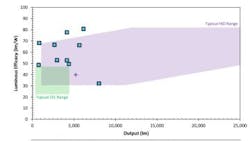Are LED floodlights up to snuff?
U.S. Dept. of Energy's (DOE) CALiPER program tests particular types of lighting products to figure out what kind of performance metrics are state of the art. Most recently, the CALiPER program looked at LED floodlights – not an easy category to measure because there are different definitions of what constitutes a floodlight.
The DOE says conventional floodlights can put out more than 20,000 lumens, but few (if any) LED floodlights can match this performance. The maximum lumen output the DOE measured in the CALiPER test was 8,000 lumens. Currently, it takes a large surface area for numerous LED packages to generate a high lumen output. LEDs can be driven at higher operating currents to increase light output, but among other tradeoffs, lifetime usually decreases. Improvement in LED packages will help resolve this limitation, DOE says, but it is likely a long‐term challenge.
The efficacy of many of the LED floodlights DOE tested was equal to or better than the typical efficacy of conventional floodlights using metal halide or CFL lamps. Most of the LED floodlights in the test had wide, symmetric distributions. For many applications, this is not appropriate, DOE says, which limits the market for LED products. Because LED floodlights require an array of LEDs, rather than the single point source of a metal halide floodlight, producing narrow spot distributions can be difficult.
The DOE also found LED floodlights weren't quite as flexible as their conventional competitors. Conventional floodlights often employ modular lamps, reflectors, and accessories to meet exacting performance criteria that depend on specific applications. Although some of the tested LED floodlights followed a similar approach, others offered no variation, DOE says.
But although color rendition is not as important for floodlights as it is for some other product categories, DOE says it is one area where LEDs have a potential advantage. Unfortunately, many of the LED floodlights DOE tested did not exploit this opportunity, and many had CCTs outside the typical range for the competing conventional floodlights. On the other hand, the color consistency and color stability of LED floodlights is likely better than that of conventional floodlights using metal halide lamps, DOE says.
DOE's report also notes that the power factor of the LED floodlights it tested was considerably better than that of conventional floodlights. And although not specifically examined or measured by CALiPER, the rated lifetime of LED floodlights is typically as long or longer than the rated lifetime for conventional floodlights.
Finally, as with all LED products, manufacturer claims must be accurate. Four of the ten tested products failed to meet at least one manufacturer claim.
The full DOE CALiPER report is free and is available here: http://apps1.eere.energy.gov/buildings/publications/pdfs/ssl/caliper_15_summary.pdf
